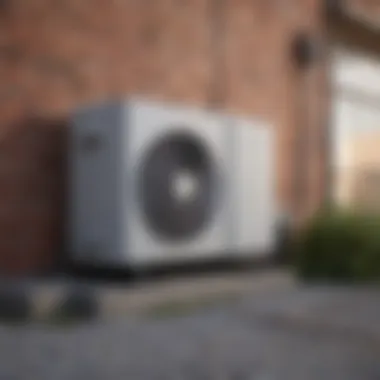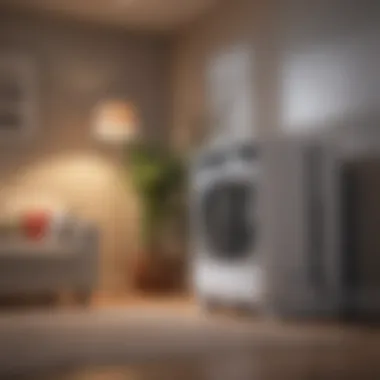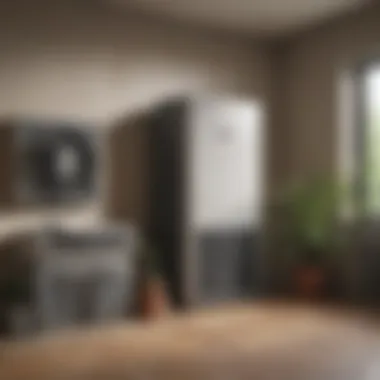Understanding the Costs of Installing a New Air Conditioner


Intro
Understanding the financial landscape when it comes to purchasing a new air conditioner is essential. Many people overlook the associated costs, leading to misinformed decisions. The factors that influence pricing are numerous, ranging from the specific type of unit selected to the unique nuances of regional market conditions. This article will provide a thorough examination of these elements. It also considers budget strategies, financing avenues, and ongoing maintenance costs, aiding you in navigating the complexities of this HVAC investment.
Understanding Loans
When delving into the costs of installing a new air conditioning unit, financial considerations often arise. Many individuals seek loans to offset these expenses. Understanding the available loan types is vital to making an informed decision.
Types of Loans
- Personal Loans: These are typically unsecured loans, meaning no collateral is required. They are suitable for covering initial costs along with labor during installation.
- Home Equity Loans: These loans use your home's value as collateral, often leading to lower interest rates.
- Credit Financing: Some HVAC companies offer in-house financing options that often include promotions like cashback or deferred payments.
Loan Eligibility Criteria
When applying for a loan, certain conditions must usually be met. Factors include your credit score, annual income, and existing debt levels. Generally, a score above 600 is favorable for most lenders, but each institution may have its specific requirements.
Pros and Cons of Taking Out a Loan
Before proceeding, consider these Advantages:
- Access to immediate funds.
- Potential lower interest rates, especially with secured loans.
Drawbacks:
- Interest payments may add up over time.
- Risk of falling into debt if not managed properly.
Budget Considerations
Having a clear understanding of your budget allows you to weigh options effectively. Essential costs related to purchasing a new air conditioner include not just the unit but also installation, taxes, and any necessary upgrades to existing ductwork.
Researching Potential Costs
To minimize unexpected expenses, it is prudent to contact multiple HVAC dealers and compare quotes. Verify if installation costs are integrated into the final price or if they are separate.
Preventative Maintenance Expenses
Once installed, your air conditioning unit will require servicing. Regular maintenance is crucial to prolonging the lifespan of the unit and identifying potential issues early.
Energy Efficiency Ratings
The energy efficiency rating of the air conditioner affects both the upfront cost and ongoing expenses. Higher-rated units often have greater initial price tags but can result in lower energy bills overall. Understanding metrics like SEER (Seasonal Energy Efficiency Ratio) can guide informed choices.
A higher SEER rating traditionally correlates with improved energy usage and efficiency.
This decision-side guide will empower you with the necessary insight to assess air conditioning costs effectively alongside the financial aspects of these purchases.
Prelims to Air Conditioner Costs
Understanding the costs of a new air conditioner unit is essential for making an informed purchase in today’s market. This section presents an in-depth look at why these costs matter. It guides readers through various aspects of air conditioning, from selection to long-term expenses.
Importance of Understanding Costs
Recognizing the costs associated with air conditioner units is not just about the initial purchase price. A good air conditioner can affect your energy bills, configuration options, and overall comfort in your home. By understanding these cots, consumers can make better decisions that fit within their budgets. Moreover, knowing the fine details helps in predicting and controlling future expenses. For example, an energy-efficient model might have a higher upfront cost but may lead to substantial savings over time. Thus, this understanding helps to balance immediate financial constraints against long-term economic benefits.
Overview of the Air Conditioning Market
The air conditioning market is diverse and competitive. Many brands and models cater to varying needs and budgets, making it essential to explore these options fully. Models vary not only in price but also in features, performance, and energy consumption. The market itself is driven by consumer demand for more energy-efficient models and advancements in technology.
Current market trends show a growing awareness of climate impact and energy efficiency. The demand for eco-friendly air conditioning systems is on the rise. Brands such as Carrier and Lennox dominate the market due to their innovations in energy efficiency. Choices in the marketplace affect how much one might expect to spend on both the immediate purchase and future maintenance, making it essential to be aware of available options and their impacts on your wallet.
This understanding can lead to significant long-term savings by choosing units that complement your living environment and usage patterns.
Factors Influencing Air Conditioner Prices
Understanding the various factors that influence air conditioner prices is essential for making informed decisions when purchasing a new unit. As air conditioning units can be a substantial investment, recognizing the distinct components and their impacts can significantly affect overall costs. Factors such as the type of unit, energy efficiency, and size, among others, dictate pricing levels.


Each element plays a critical role in the final price of an air conditioning system and understanding these elements allows consumers to navigate the market thoroughly. Making decisions based on this knowledge can lead to cost savings in both the short and long term, combining both purchase and operational efficiency.
Type of Air Conditioner Units
Central Air Conditioning Systems
Central air conditioning systems provide uniform cooling throughout larger spaces and connect to ducts already present in the house. Their ability to cool an entire area serves as a key characteristic drawing many homeowners to this choice. Unlike other types, they typically have a longer life expectancy and enhance property resale value. However, central ACs often come with higher initial costs and complex installation requirements.
Window Units
Window units are then lower-cost alternatives specifically suitable for single rooms. They are compact and easy to install, making them attractive for renters or those with limited budgets. Despite their accessibility, window units usually do not offer the coverage of a central system, and multiple units may be required for larger spaces. Their limited cooling ability can affect overall effectiveness if you need to cool multiple areas.
Portable Air Conditioners
Situating a portable air conditioner in different locations gives this type both flexibility and convenience. They typically don’t need professional installation. The distinction of being easily moveable appeals to many consumers. However, they may not offer the same cooling power as other units and can sometimes be less efficient, leading to increased operational costs over time.
Ductless Mini-Split Systems
Ductless mini-split systems serve varied energy-efficient applications providing localized heating and cooling. Their installation requires less space than ducted systems, making them suitable for homes without existing ductwork. Despite their advantages, ductless systems can sometimes present high initial costs. Users should consider their specific housing needs and regional climate, which may impact pricing factors.
Energy Efficiency Ratings
SEER Ratings Explained
Seasonal Energy Efficiency Ratio, commonly known as SEER, quantifies the cooling capabilities of air conditioners relative to their electrical consumption, functioning as a standard for comparing energy efficiency. Thoroughly understanding SEER ratings proves beneficial for estimating long-term operational costs. A higher SEER rating indicates better efficiency but often involves higher upfront costs benefiting users over an extended period.
The Impact of Energy Efficiency on Pricing
Energy efficiency is a significant factor affecting air conditioner pricing. Those that have higher efficiency can result in lower utility bills. Consumers should carefully calculate potential energy savings and consider the long-term financial implications. Assigning importance to energy-efficient models could lead to better overall value.
Size and Capacity Considerations
Understanding BTU Requirements
British Thermal Units (BTUs) delineate the cooling power of an air conditioning system; hence, understanding how to calculate the BTUs necessary for a specific space is crucial. This type of knowledge allows homeowners to choose a unit appropriately sized for their particular living areas. An ideal fit leads to cost-effective operation and consistent comfort throughout the environment.
Consequences of Incorrect Size Selection
Choosing an air conditioner that's too small will strain the unit, raising energy bills, resulting in inefficiency. Alternatively, an over-sized unit will cycle on and off, causing dissatisfaction with humidity control and leading to storms with cold air. Incorrect size can prompt needless expense ensuring the proper capacity is vital for an effective air conditioning system.
Installation and Labor Costs
Understanding installation and labor costs is essential when considering a new air conditioner. While the purchase price of the unit is a significant factor, the associated installation expenses can greatly influence the total investment. A well-installed cooling system not only operates efficiently but also enhances the longevity of the unit. On the contrary, poor installation can lead to higher energy bills and even premature equipment failure. Therefore, comprehending these costs allows homeowners to make informed decisions, safeguarding their financial investments.
Average Installation Costs
When it comes to air conditioner installation, costs can vary widely based on several factors. On average, consumers can expect to pay between $2,000 and $4,500 for a full installation. This estimate typically covers labor, parts, and any necessary accessories. Of course, prices can fluctuate depending on unique project needs, such as ductwork adjustments or additional equipment to meet system specifications.
Factors Affecting Labor Expenses
Labor expenses can be another substantial component of the overall cost to install an air conditioning unit. Some key factors that shape these costs include:
Location-Based Variations
Location plays a pivotal role in determining labor rates. Regions with higher living costs or tighter labor markets generally see elevated installation costs. For instance, metropolitan areas often present pricing challenges due to demand and real estate costs. In contrast, rural areas may have lower labor rates, potentially making installation more affordable, but the availability of skilled labor can vary.
"Engaging with local HVAC experts is vital. Compare quotes from multiple contractors to grasp market rates more accurately."
Complexity of Installation
The complexity of an installation significantly affects labor fees. Tasks such as retrofitting existing systems or installing a central air conditioning system with extensive ductwork inherently demanding more than simple replacement jobs will necessitate hired professionals. Workers with specialized certifications will invariably command higher wages. However, the price may pay off in energy efficiency and effectiveness, underlying a crucial consideration when evaluating potential savings when using energy-efficient units.
Regional Pricing Differences
Understanding regional pricing differences is essential when considering a new air conditioner unit. These costs greatly affect how much you will eventually pay for your system and its installation. Price variations can arise from numerous factors, including local economies, weather, and demand for air conditioning systems. Recognizing these elements can help establish a realistic budget and assist in making informed decisions.
Cost Variations Across States


Northern vs.
Southern States
The pricing for air conditioners markedly varies between northern and southern states. Southern regions generally experience warmer temperatures for longer periods within the year, which promotes a higher demand for air conditioning units. This demand drives prices higher, yet it balances out with increased sales volume, enabling competitive pricing among sellers.
On the other hand, northern states tend to have milder summers and shorter usage durations for air conditioners. Consequently, prices may be lower since fewer units are sold. However, homeowners in these areas might still prioritize energy efficiency to combat extreme weather changes, which can compromise price elasticity.
One key characteristic is the installation costs attributed to each region. Southern states often have more HVAC professionals available, leading to competitive installation prices. In contrast, the lesser demand and fewer professionals in northern states can result in higher labor costs owing to limited options.
Urban vs.
Rural Pricing
Urban and rural pricing showcases another critical aspect of how geographical location impacts costs. Urban areas typically have higher living expenses that correlate with increased air conditioner pricing. Reduced space and zoning laws can rise installation costs due to potential structural adaptations that some buildings require.
Conversely, in rural areas, there might be lower initial purchase prices due to reduced competition. However, transportation costs can inflate expenses for getting the equipment delivered. Furthermore, there may be fewer qualified HVAC technicians in rural locales, leading to greater overall installation costs and longer wait times.
Understanding these dynamics can lead to better financial choices when purchasing a unit. Factors such as climate and populations density create a stark contrast in pricing that buyers must acount for.
Impact of Climate on Price
The climate does not only determine how often air conditioning units are used but also heavily influences the pricing. Certainly, in hotter climates, higher energy ratings can be beneficial for reducing long-term energy costs, yet they may also incur a higher upfront expense. This plays a crucial role in convincing consumers to invest more initially to reap substantial savings in future energy bills while enhancing their comfort.
Also, possible energy efficiency regulations introduced by state governments can considerably affect the costs; higher-efficiency units may be priced elevatedly in states with stringent regulations.
Understanding the climate and regional differences will allow consumers to anticipate not only the costs of a new unit but also long-term expenditure considerations.
Budgeting for a New Air Conditioner
Understanding the cost of a new air conditioner involves meticulous budgeting. A thoughtfully planned budget allows buyers to gauge the financial requirements that come with purchase and installation. Beyond mere acquisition, it covers future expenses such as energy consumption and contingent repair costs.
Going about budgeting requires deep consideration for each expenditure. A concrete estimate informs prospective buyers on what they stand to invest. It opens paths for aligning their financial resources with their specific needs, ensuring neither under-purchasing nor overspending occurs. With varied types and capacities available, buyers must see value for money grounded in their own financial narratives.
Total Cost Estimation
The equation of total costs calculates much more than just the initial sticker price of an air conditioning unit.
Initial Purchase Price
The initial purchase price is often the most visible cost. It is the upfront payment made to acquire an air conditioning system. A thorough look reveals its traits that make it a substantial element in budgeting, as it represents a one-time outflow of a significant amount.
- Key Characteristic: Affordability can vary greatly among different brands, features, and models. Knowing what you expect in terms of specifications helps in choosing wisely.
- Advantage: Being an identifiable expense, it allows for straightforward comparisons among various units. Budgeting helps buyers discern straightforward options, primarily dependent on set limits.
- Disadvantage: Focusing only on initial purchase prices may overlook critical long-term financial aspects, such as operational costs.
Installation Expenses
Installation expenses should not be an afterthought. It covers all costs needed to successfully integrate your air conditioning unit into your existing infrastructure. Another determining variable affecting the overall budget.
- Key Characteristic: These costs can substantially differ based on the kind of system chosen and whether prior modifications to ductwork are needed. Getting several estimates before concluding is wise.
- Advantages: Knowing the estimation ensures there are no unexpected costs or surprises at final billing stages. A well-planned installation ensures efficiency and optimal operation from day one.
- Disadvantage: This all-important part can sometimes elude qualifications when the upfront price highlights buyer attention.
Future Maintenance Costs
Estimating future maintenance costs is vital but is often overlooked in initial budgeting. It accounts for repairs and periodic services that enhance longevity and thus protect the original investment.
- Key Characteristic: Maintenance can differ remarkably between types of systems. Ductless mini-split systems could offer lower upkeep compared to central units.
- Advantage: By discerning typical timelines and costs of maintenance schedules, buyers create a manageable expense map that spans years beyond purchase.
- Disadvantage: Possible inconsistency or unplanned costs may catch the buyer unaware, alerting a dire need for establishing a maintenance fund.
Comparing Costs Against Value
Examining costs in relation to published benefits solidifies effective choices made in both short and long-term scenarios. In doing so, the conversation turns from how much something costs to what worth do buyers gain through these investments. The principle of obtaining value echoes wider success in overseeing HVAC operations while securing a stable financial footing down the line. Evaluating performance metrics, customer reviews, and guides enhance this picture further.
Principles range widely. What might seem an over-budget option could pay dividends through durability and efficiency.
Thus, as buyers prepare their budgets around a new air conditioning unit, grasping the total costs and contrasting them against value not only gratifies them financially but encourages enlightenment on what their investment accomplishes overall.
Financing Options for Air Conditioner Purchases
Considering a new air conditioner is a significant investment, handling the resulting expenses is crucial. Financing options provide avenues to turn this investment into manageable payment structures. Understanding these options allows individuals to assess the best route for your financial situation without compromising the immediate comfort needs. Managing cash flow efficiently becomes imperative, especially during peak sale seasons. Those who need an air conditioner often face urgency in replacing it, further complicating your purchasing decision.


Proper financing can aid in balancing the cost of a new air conditioner while meeting unexpected needs.
Personal Loans vs.
Credit Cards
When weighing financing options, both personal loans and credit cards stand out as practical choices, yet they carry diverse implications. Personal loans typically offer fixed interest rates, allowing precise budget planning. On the other hand, credit cards offer more flexibility, but might come with higher variable rates. Interest accumulation can be rapid with credit usage. Therefore, users must pay extra attention to the annual percentage rate, fees, and potential penalties—especially if opting for credit cards.
Here are comparisons to consider:
- Interest Rates: Personal loans offer fixed rates, often lower than credit cards.
- Repayment terms: Loans usually provide structured repayment options that vary, whereas credit cards resemble a revolving line of credit.
- Impact on Credit Score: Both options will reflect on credit, but they do so differently; loans affect it when obtaining and repaying, while credit cards depend heavily on utilization.
Manufacturer Financing Plans
Many manufacturers available in the market offer their own financing options. These financing plans often come with promotional interest rates or even zero-interest periods. They provide terms that allow customers to purchase an air conditioning unit without putting heavy strain on finances at one's depreciation point.
Available conditions can include:
- Lower Initial Payments: Attractive monthly payment options can ease budget stress.
- Special Deals/Offers: Frenzied catalogue styles may attract limited-time offers with embedded financing.
- Credit Pre-Approval Process: Some manufacturers may streamline billing processes due to knowing stock, enhancing decision-making speed.
In choosing between personal loans, credit cards, or manufacturer financing plans, individuals must assess their specific financial situations. This assessment often influences overall expense management in acquiring air conditioning effectively.
Maintenance and Long-term Costs
In the scope of purchasing a new air conditioner unit, understanding maintenance and long-term costs is vital. These are often unseen expenses that can undermine the initial investment. Proper maintenance can enhance a unit's lifespan, efficiency, and performance, helping to mitigate future expenses.
Regular attention to maintenance not only reduces operating costs but also preserves warranty protections and ensures compliance with specified standards.
Regular Maintenance Expenses
Regular maintenance of an air conditioning unit involves several tasks. These include checking refrigerant levels, inspecting ducts for leaks, cleaning filters, and verifying the electrical components' functionality. Engaging a professional service for these tasks can lead to an additional ongoing cost.
Maintenance frequency is commonly suggested twice a year, ideally before summer and winter. Seasonal check-ups can vary in price based on the service provider. Generally, you might pay between $75 to $200 per visit. These costs are an investment towards future savings. For example:
- Preventative maintenance reduces sudden breakdowns.
- Identifying potential failures early can avert more expensive repairs.
- Efficiency levels maintained can lower energy bills.
Investing in a maintenance plan with your service provider is another way to manage these costs. Under such plans, you may receive annual check-ups at a discounted rate, possibly reducing long-term expenses significantly.
Understanding Warranty Protections
Warranties often accompany new air conditioners, offering peace of mind regarding repairs and parts. However, understanding the insulation of these warranties is key to maximizing their value. Most manufacturers provide basic coverage for failures under normal use, usually spanning from five to ten years.
Warranties typically only apply if proper maintenance is performed. Failing to maintain the system could void warranty protections. Additionally, some vendors provide extended warranty options for an extra fee. Evaluating these options is crucial, as they may cover:
- Parts replacements
- Service calls
- Specific repairs
To ensure complete understanding of the fine print, quantify everything included in the warranty. Always confirm that your chosen service provider adheres to the stipulated maintenance schedule required by the warranty. Otherwise, you risk incurring additional costs if something goes wrong beyond the warranty period.
Finale: Making Informed Decisions
Making an educated choice when purchasing a new air conditioner entails understanding various factors at play. This article has broken down costs and offered insights on unit selections, financing options, and long-term expenses. However, the key is to weigh both short-term expenses against potential long-term savings. By approaching the acquisition with a solid framework, it's possible to align personal financial goals with the right HVAC solution.
Weighing Short-term vs.
Long-term Investments
Purchasing an air conditioner represents both immediate and future financial commitments. In the short term, one might face high initial costs associated with acquiring the unit and its installation. Conversely, the long-term perspective reveals the continuously rising utility bills, particularly for lower efficiency models. Considerations should extend beyond mere purchase price.
- Initial Investment: This is the cost of the unit itself and any immediate installation services. High-end models typically avow themselves to strong customer satisfaction reports, but these can have substantial upfront costs.
- Ongoing Expenses: Paying attention to energy consumption is crucial. Frequent repairs on the older units will decrease the customer’s budget over time.
In summary, existing concerns about upfront costs must be balanced with future savings yielded by energy-efficient units.
The Role of Energy Efficiency in Future Savings
The role of energy efficiency in determining the affordability of an air conditioner cannot be overstated. Units with higher energy efficiency ratings not only save on monthly bills but also shield against larger maintenance expenses. Implementing efficient practices reduces operational costs significantly over time.
It is evident that units bearing an impressive SEER (Seasonal Energy Efficiency Ratio) rating often translate to lower energy bills specifically during peak usage months.
- Number of years of saving: Evaluate how much will be saved daily, both in potential repairs and in utility bills provided.
- Environmental Impact: Installing a unit with improved efficiency over time can mean reduced emissions as less energy is consumed.
The myriad benefits associated with selecting the best performing options ultimately underscores how wise investments aid users in achieving maximized potential over time.
Choosing energy-efficient models can offer unexpected gains that extend beyond the immediate effects on one’s wallet. Sustainability in one’s choices leads to lasting advantages and enhances planet care, alongside personal savings.







